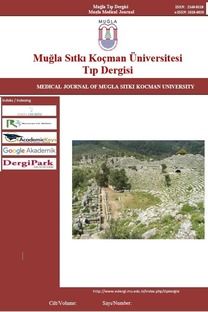Kronik Rotator Manşet Yırtıklarının Cerrahi Tedavisinde Klinik Sonuçlarımız: Retrospektif Karşılaştırmalı Çalışma
Artroskopik Cerrahi, Mini Açık Teknik, Rotator Manşet, Tam Kat Yırtık
Surgical Treatment Outcome of Chronic Rotator Cuff Tears: A Retrospective Comparative Study
___
- 1. Büker N, Kitiş A, Akkaya S, Akkaya N. Comparison of theresults of supervisedphysiotherapy program andhome-basedexercise program in patientstreatedwitharthroscopic-assisted mini-openrotatorcuffrepair. Eklem Hastalik Cerrahisi. 2011;22(3):134-9.
- 2. Daniels SD, Stewart CM, Garvey KD, Brook EM, Higgins LD, Matzkin EG. Sex-BasedDifferences in Patient-Reported Outcomes After Arthroscopic Rotator Cuff Repair. Orthop J Sports Med. 2019;7(11):2325967119881959.
- 3. Bayam L, Kıran E, Erdem M, Kochai̇ A, Türker M. Rotator Manşet Yırtıklarında Artroskopik Yardımlı Mini Açık ve Artroskopik Tamir Yöntemlerinin Klinik ve Radyolojik Sonuçlarının Karşılaştırılması. Sakarya Tıp Derg. 2018; 8(4): 788-97.
- 4. Karaman O, Karakus O, Saygi B. A comparison of full arthroscopic and arthroscopic-assisted mini-open repair methods in rotator cuff tears 1-3 cm in size. J Orthop. 2018;15(3):894-8.
- 5. Çelik H, Seçkin MF, Akman Ş. Rotator manşet cerrahisinde komplikasyonlar. Okmeydanı Tıp Derg. 2017;33:155-63.
- 6. Kaya İ, Uğraş A, Ertürk A, et al.Artroskopikrotator manşet tamiri. Şişli Etfal Hast Tıp Bül. 2013; 47(1): 21-4.
- 7. Ati̇k A. The Role of Arthroscopic Decompression in Subacromial Impingement Syndrome. Acta Medica Alanya. 2019; 248-53.
- 8. Liu J, Fan L, Zhu Y, Yu H, Xu T, Li G. Comparison of clinical outcomes in all-arthroscopicversus mini-open repair of rotator cuff tears: A randomized clinical trial. Medicine (Baltimore). 2017;96(11):e6322.
- 9. Iyengar JJ, Samagh SP, Schairer W, et al. Current trends in rotator cuff repair: surgical technique, setting, and cost. Arthroscopy. 2014; 30(3): 284–8.
- 10. Van der Zwaal P, Thomassen BJ, Nieuwenhuijse MJ, et al. Clinical outcome in all-arthroscopic versus mini-open rotator cuff repair in small to medium-sized tears: a randomized controlled trial in 100 patients with 1-year followup. Arthroscopy. 2013 ;29(2):266-73.
- 11. Zhang Z, Gu B, Zhu W, Zhu L, Li Q. Arthroscopic versus mini operotator cuff repair: a prospective, randomized study with 24-month follow-up. Eur J Orthop Surg Traumatol. 2014; 24(6): 845–50.
- 12. Nazari G, MacDermid JC, Bryant D, Dewan N, Athwal GS. Effects of arthroscopic vs. mini-open rotator cuff repair on function, pain&range of motion. A systematic review and meta-analysis. PLoSOne. 2019;14(10):e0222953.
- 13. Morse K, Davis D, Afra R, KrallKaye E, Schepsis A, Voloshin I. Arthroscopic versus mini-open rotator cuff repair. A comprehensive review and meta-analysis. Am J Sports Med. 2008; 36(9):1824-8.
- 14. Youm T, Murray DH, Kubiak EN, Rokito AS, Zuckerman JD. Arthroscopic versus mini-open rotator cuff repair: a comparison of clinical outcomes and patient satisfaction. J Shoulder Elbow Surg. 2005;14(5):455-9.
- 15. Nho SJ, Shindle MK, Sherman SL, Freedman KB, Lyman S, MacGillivray JD. Systematic review of arthroscopic rotator cuff repair and mini-open rotator cuff repair. J Bone Joint Surg. 2007;89(3):127-36.
- 16. Jancuska J, Matthews J, Miller T, Kluczynski MA, Bisson LJ. A Systematic Summary of Systematic Reviews on theTopic of the Rotato rCuff. Orthop J Sports Med. 2018;6(9):2325967118797891.
- 17. Barnes LA, Kim HM, Caldwell JM, et al. Satisfaction, function and repair integrity after arthroscopic versus mini-open rotator cuff repair. Bone Joint J. 2017;99(2):245‐9.
- 18. Huang R, Wang S, Wang Y, Qin X, Sun Y. Systematic Review of All-Arthroscopic Versus Mini-Open Repair of Rotator Cuff Tears: A Meta-Analysis. Sci Rep. 2016; 6: 22857.
- 19. Hui YJ, Teo AQ, Sharma S, Tan BH, Kumar VP. Immediate costs of mini-open versus arthroscopic rotator cuff repair in an Asian population. J Orthop Surg (Hong Kong). 2017;25(1):2309499016684496.
- 20. Ji X, Bi C, Wang F, Wang Q. Arthroscopic versus mini-open rotator cuff repair: an up-to-date meta-analysis of randomized controlled trials. Arthroscopy. 2015;31(1):118-24.
- 21. Köse KC, Tezen E, Cebesoy O, et al. Mini-open versus all-arthroscopic rotator cuf frepair: comparison of the operative costs and the clinical outcomes. 2008; 25(3):249-59.
- 22. Churchill RS, Ghorai JK. Total cost and operating room time comparison of rotator cuff repair techniques at low, intermediate, and high volume centers: mini-open versus all-arthroscopic. J Shoulder Elbow Surg. 2010;19(5):716-21.
- 23. Kang L, Henn RF, Tashjian RZ, Green A. Early outcome of arthroscopic rotator cuff repair: a matched comparison with mini-open rotator cuff repair. Arthroscopy. 2007;23(6):573-82.
- 24. Uğurlar M, Sönmez MM, Uğurlar ÖY, Sarı A, Ere OT. Arthroscopic-Assisted Repair in Full-Thickness Rotator Cuff Ruptures: Functional and Radiologic Results of Five-Year Follow-Up. Dicle Med J. 2016;43(2):290-3.
- 25. Ozbaydar MU, Tonbul M, Yurdoğlu C, Yalaman O. Arthroscopic-assisted mini-open repair of rotator cuff tears. Acta Orthop Traumatol Turc. 2005;39(2):121-7.
- 26. Kanatlı U, Ayanoğlu T, Ataoğlu MB, et al. Midterm outcomes after arthroscopic repair of partial rotator cuff tears: A retrospective study of correlation between partial tear types and surgical technique. Acta Orthop Traumatol Turc. 2020; 54(2): 196-201.
- ISSN: 2148-8118
- Yayın Aralığı: 3
- Başlangıç: 2014
- Yayıncı: Muğla Sıtkı Koçman Üniversitesi
Anıl GÜLCÜ, Serkan AYDIN, Ahmet ASLAN
Rukiye ÇİFTÇİ, FATMA KIZILAY, Şeyma TOY, Deniz ŞENOL, Betül AKYOL, Yüksel ERSOY, Davut ÖZBAĞ
Makine Öğrenmesi ile Radyolojik Görüntülerden Kemik Yaşı Tahmini
Nida GÖKÇE NARİN, Önder YENIÇERI, Gamze YÜKSEL
Bruksizmde Botulinum Toksini Etkinliğinin Değerlendirilmesi
Ozan KUDUBAN, Selma DENKTAŞ KUDUBAN
Ali İhsan UYSAL, BAŞAK ALTIPARMAK, Melike KORKMAZ TOKER, Süleyman Cüneyt KARAKUŞ, Semra GÜMÜŞ DEMİRBİLEK
Yetişkinlerde Koroner Arter Fistülleri: Koroner BT Anjiyografi ile Değerlendirme
Türkiye Güneybatısı’ndan Retrospektif Çalışma: Koroziv Madde Alımına Minimal İnvaziv Yaklaşım
Alev SUZEN, Nazile ERTÜRK, Süleyman Cüneyt KARAKUŞ, Meral GÜÇLÜ
Sporcularda Kronik Dental Lezyonların Kas Kuvvetine Etkisi
Tuğba KOCAHAN, Osman HAMAMCILAR, Aydın BALCI, BİHTER AKINOĞLU, Nevres Hürriyet AYDOĞAN, Adnan HASANOĞLU
Gebeliğin İntrahepatik Kolestazı
Mehmet Ferdi KINCI, Özge ŞEHİRLİ KİNCİ, Ezgi KARATAŞ
Coronary Artery Fistulas in Adults: Evaluation with Coronary CT Angiography
